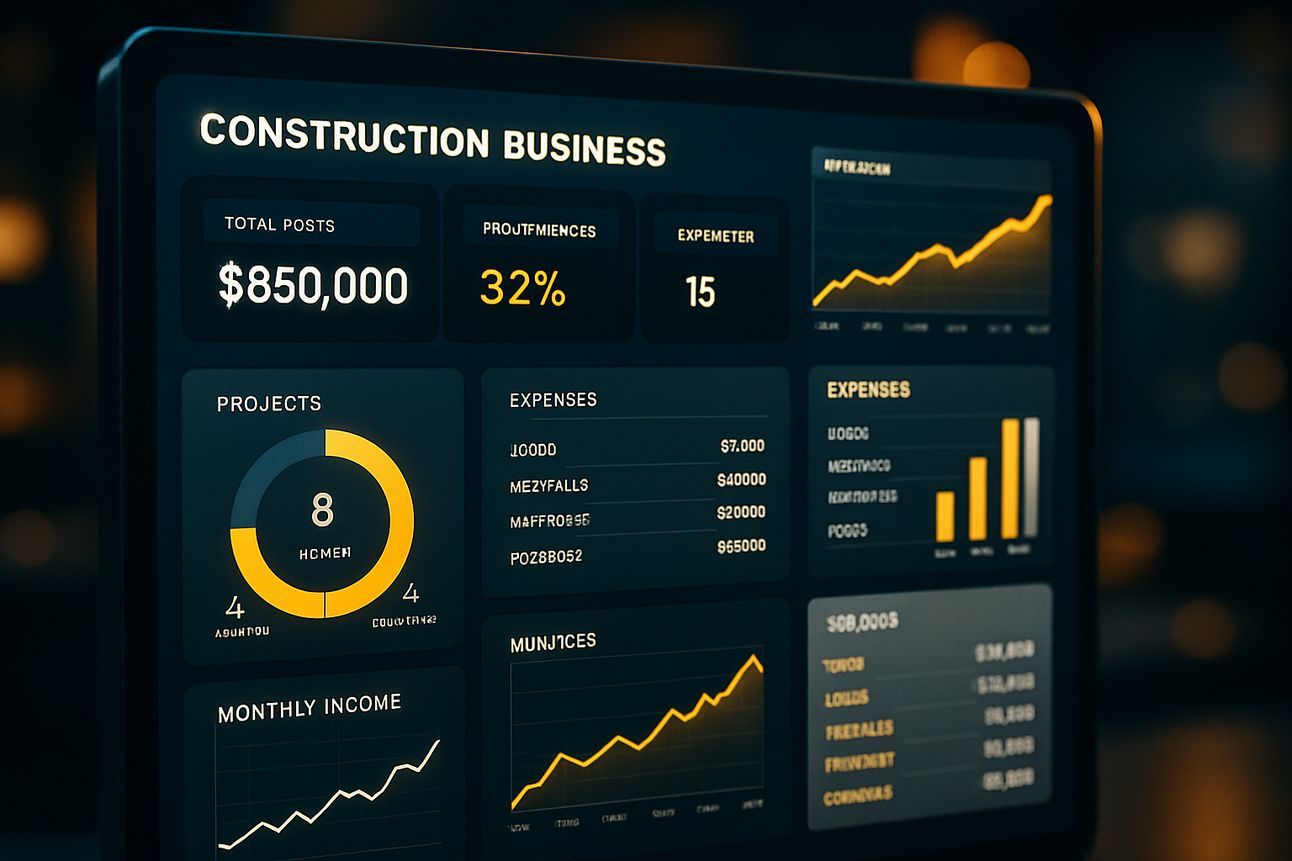Many builders struggle with low net profits despite high revenue. Learn to master gross and net profit margins, avoid the markup vs. margin trap, and implement an action plan for sustainable financial health in your construction business.
TABLE OF CONTENTS
Let's cut straight to it. For your building business, clarity on profit margins isn't academic; it's the bedrock of financial health and your path to real growth. Many builders hit the "busy but broke" wall, pushing $1-5 million in revenue yet consistently seeing net profits stuck around a risky 5%. Industry benchmarks tell us that for sustainable growth and a cushion for reinvestment, you should be targeting at least 10% net profit, with 20% being truly healthy.
Here’s the breakdown you need to stop bleeding cash and get ahead:

An illustrated construction worker navigating the complexities of a busy but financially strained building business.
01. Gross Profit Margin vs. Net Profit Margin: Get Your Definitions Straight
Understanding these two is non-negotiable for true profitability:
Gross Profit Margin (GPM): This shows the profitability of your core projects, specifically your ability to deliver work efficiently. It's calculated as (Revenue - Cost of Goods Sold) / Revenue. Your Cost of Goods Sold (COGS) includes all direct costs: labor, materials, subcontractors, and equipment directly tied to a project. A healthy GPM is typically 25% or more; it needs to be robust enough to cover your overhead.
Net Profit Margin (NPM): This is your ultimate bottom line, the true measure of your business’s overall financial performance. It's the percentage of revenue remaining after all expenses have been deducted—that's your COGS, plus all your indirect operating expenses (OpEx) like rent, administrative salaries, marketing, utilities, interest, and taxes. This number tells you how much of every dollar of revenue you actually keep.
📐 QUICK START: MARGIN CLARITY CHECK Grab your latest Profit & Loss statement. Can you clearly identify your GPM and NPM for the last quarter? If not, or if those numbers are a surprise, your immediate task is to work with your bookkeeper or accountant to ensure your financial reports are accurately categorizing COGS and OpEx so these crucial margins are clear and reliable. This is ground zero for financial control.
02. The Costly Myth: "Markup Does Not Equal Profit!"
This is one of the most common and damaging mistakes builders make, and it can silently kill your margins.
Markup: This is a percentage you add to your cost to arrive at the selling price. So, if a job costs $10,000 and you apply a 20% markup, you add $2,000 to get a selling price of $12,000.
Margin: This is a percentage of the selling price. In the example above, your profit is $2,000 on a $12,000 selling price, which is a 16.67% margin, not 20%.

A construction business owner reviewing financial documents with a calculator and blueprints in a professional, high-tech setting with warm lighting, focused on financial growth and profitability.
The Trap: Confusing these terms leads to underpricing and leaves money on the table, making it impossible to cover all your costs and hit a healthy net profit. A surprising number of builders (over 12%) believe they understand this distinction but don't. You need to be acutely focused on achieving your target margins, not just applying a markup.
03. Calculating True Profitability: Your Action Plan
To escape the "busy but broke" cycle and drive sustainable profits, you need to attack these issues head-on. It's about proactive control, not just reacting to your bank balance:
Master Your Financials:
Get Literate: You need to truly understand your financial statements. This isn't just "accounting stuff"; it's crucial for confident decision-making and reduced stress.
Track Everything Accurately: Implement meticulous bookkeeping using robust accounting software. Without accurate tracking, you can't truly see where your money is going or coming from.
Budget and Forecast: Create a realistic budget and regularly forecast your cash flow. Consider systems like "Profit First" to proactively set aside profit before expenses, forcing efficiency and building financial resilience.
Monitor KPIs: Move beyond just revenue. Track key performance indicators like Gross Profit Margin per job, overall Gross Profit Margin, Overhead Rate, and Net Profit Margin. Builders who consistently monitor their gross margin see a significantly higher net profit margin (7% vs. 3%).
📐 QUICK START: RECALCULATE YOUR LAST BID Take the detailed cost estimate from the very last job you bid on. What markup did you apply? Now, calculate what your actual Gross Profit Margin was based on the selling price. Next, recalculate what the selling price should have been if you were targeting a robust 25% or 30% GPM. Is there a gap? That gap is lost profit potential. This exercise can be a serious wake-up call.

construction business owner transitioning from stressed with paperwork to confident with organized financial documents, split image showing before and after, professional setting
Price for Value, Not Just Cost:
Know Your True Costs: You can't price effectively if you don't know your true job costs (COGS) and overhead (OpEx) down to the penny. Hidden costs, like inaccurate labor burden rates, silently drain your profits.
Shift to Value-Based Pricing: Your price should reflect the unique value, solutions, and peace of mind you provide to clients, not just your internal costs. This allows for higher margins.
Review and Adjust Regularly: Prices aren't static. You need to adjust them to account for rising material and labor costs, market changes, and your evolving value proposition. Don't let the fear of raising prices erode your margins.
Research the Market: Understand competitor pricing and what clients are willing to pay. This isn't about starting a price war, but about smart positioning.
Implement Disciplined Cost Control:
Accurate Classification: Meticulously track and correctly classify costs as either direct (COGS) or indirect (OpEx). Misclassifying expenses can create a misleading picture of your gross profitability.
Optimize COGS: Actively negotiate better terms with suppliers, optimize inventory, and improve production or service delivery efficiency to reduce waste.
Fight OpEx Creep: As your business grows, operating expenses have a natural tendency to creep up, silently eroding your net profit. Regularly scrutinize all expenses line by line, challenging every cost and cutting non-essential spending.
📐 QUICK START: YOUR 30-DAY OPEX CHALLENGE For the next 30 days, dedicate one hour each week (four hours total) to an "OpEx Deep Dive." Pull up your detailed operating expense report. Pick 2-3 line items each week. Ask: Is this expense absolutely vital to our operations or revenue generation? Can we negotiate a better price with the current vendor? Are there alternative, more cost-effective solutions available? Can we reduce consumption or usage? Your goal: Identify at least three operating expenses you can reduce or eliminate, saving your company tangible money within the next 60 days.
The Bottom Line
You can't fix what you don't measure. Take control of your numbers, and you take control of your destiny as a builder. This isn't about fancy theories; it's about practical, actionable steps that lead to more money in your pocket and a more resilient business.

An illustrated dashboard displaying a comprehensive set of financial metrics and data inputs for a construction business, presented in a sleek, high-tech visual style.

